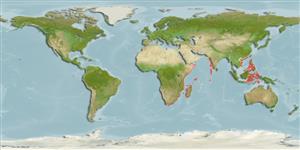Classification / Names
Common names from other countries
Main reference
Size / Weight / Age
Max length : 30.0 cm TL male/unsexed; (Ref. 1371)
Environment
Marine; bathydemersal; non-migratory; depth range 183 - 772 m (Ref. 1371), usually 350 - 550 m (Ref. 1371)
Climate / Range
Deep-water, preferred ?; 22°N - 44°S, 20°E - 131°E (Ref. 1371)
Distribution
Indian Ocean: off South Africa and Mozambique. Western Pacific: southern Japan, Taiwan, South China Sea near Hong Kong, Philippines, and Borneo.
Countries | FAO areas | Ecosystems | Occurrences | Introductions
Short description
Dorsal
spines
(total): 2;
Anal
spines: 0. Scales medium-sized, uniformly covered with fine, conical reclined spinules in widely divergent V-shaped rows or quincunx order. Snout with a black margin along its leading edge extending posteriorly onto suborbital shelf, but not over supranarial and median nasal ridges; first dorsal fin uniformly dusky or darker proximally, but lacking a distinct black blotch.
IUCN Red List Status (Ref. 115185)
Threat to humans
Harmless
Human uses
Fisheries: minor commercial
More information
Common namesSynonymsMetabolismPredatorsEcotoxicologyReproductionMaturitySpawningFecundityEggsEgg development
ReferencesAquacultureAquaculture profileStrainsGeneticsAllele frequenciesHeritabilityDiseasesProcessingMass conversion
Tools
Special reports
Download XML
Internet sources
Estimates of some properties based on models
Phylogenetic diversity index
PD50 = 0.5000 many relatives (e.g. carps) 0.5 - 2.0 few relatives (e.g. lungfishes)
Trophic Level
3.7 ±0.5 se; Based on size and trophs of closest relatives
Resilience
Medium, minimum population doubling time 1.4 - 4.4 years (Preliminary K or Fecundity.)
Vulnerability
Moderate vulnerability (38 of 100)
Price category
